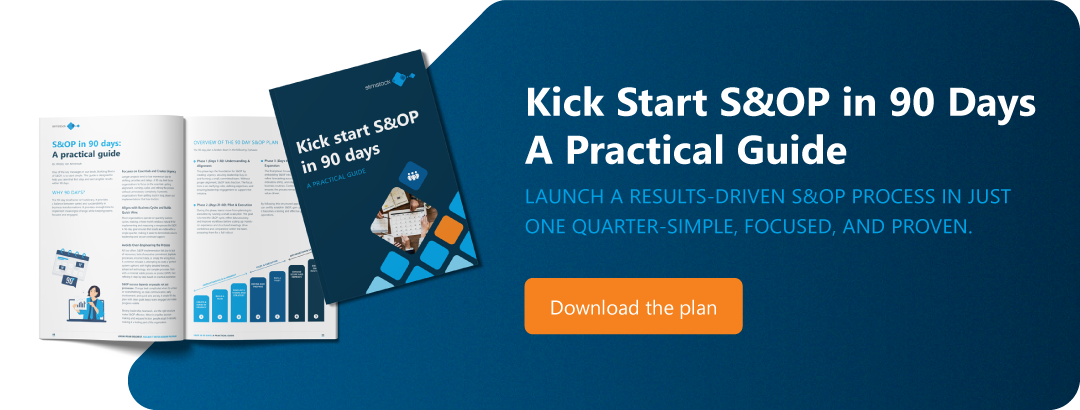Table of contents
Table of contents- Why product & category management should contribute to S&OP
- The strategic lens of product and category management
- Why product management participation matters
- What product & category managers gain
- How can we best leverage product & category managements skills
- Conclusion
Sales & Operations Planning (S&OP) is traditionally seen as a supply chain planning discipline. It’s where demand is balanced with supply, and where financial goals and are reconciled with operational constraints. Yet, product and category management are often underrepresented in this process. In an environment with fast-changing and expanding assortments however, their contribution is critical to align new product introductions and managing the end-of-life process of products.
The strategic lens of product and category management
Product and category managers are the custodians of the portfolio. They understand the nuances of customer needs, competitive dynamics, and market trends. Product and category management shapes the product roadmap, manages lifecycles, and drives innovation. In short, they have information about products that demand planning might not have about new products coming in, product categories forecasted to take off. All highly critical to balancing demand and supply.
When they’re not actively involved in S&OP, the process risks becoming reactive – focused on managing constraints rather than shaping demand. Forecasts become purely mathematical, and wrong supply on old products will clutter already constrained production and lead to full warehouses.
Why product management participation matters
No process is successful without information. Product and category managements are owners of information which supply chain, finance and sales do not always have access to or understanding of. There are 4 key elements where PMs should contribute:
1. Lifecycle planning
From product introductions to phase-outs, timing is everything. Without PM’s input, supply teams may overproduce obsolete items or underprepare for launches. Their involvement ensures smoother transitions and better inventory alignment. In essence, product and category managers are responsible for inventory in their “new” and “end-of-life” stages, and should have a say about stocking decisions – essentially managing items through a six-stage model as shown below:
2. Portfolio optimization
S&OP is the perfect forum to evaluate product performance. Are certain SKUs underperforming? Is the assortment aligned with customer demand? Product and category managers can use this platform to make data-driven decisions about rationalization and innovation.
3. Financial alignment
Category strategies must support revenue and margin goals. By participating in S&OP, product and category managers ensure that their plans are financially viable and operationally executable.
4. Forecast accuracy with context
Product and category managers provide the “why” behind the numbers. They can explain shifts in demand due to promotions, product changes, or competitive actions. Their insights help refine forecasts and reduce bias, leading to more reliable plans.
What product & category managers gain
Joining S&OP meetings is not only about contributing information, product and category managers can also learn from other departments. There are several gains for PM’s when joining S&OP:
1. Operational visibility
Understanding supply constraints, lead times, and capacity limitations helps product and category managers make more informed decisions. It bridges the gap between aspiration and feasibility.
2. Influence and accountability
S&OP gives product and category managers a seat at the table where decisions are made. It’s an opportunity to advocate for their strategies and take ownership of outcomes.
3. Cross-functional collaboration
Regular interaction with sales, supply chain, and finance fosters alignment and trust. It breaks down silos and builds a shared understanding of priorities.
4. Strategic impact
Ultimately, participation elevates the role of product management from execution to strategy. It positions them as key contributors to business performance.
How can we best leverage product & category managements skills
To fully leverage the value of product and category management in S&OP:
- Include them in monthly S&OP and pre-S&OP meetings.
- Ensure access to relevant data – forecasts, inventory levels, sales trends.
- Encourage them to bring market intelligence and product plans.
- Define clear roles and responsibilities within the S&OP framework.
Conclusion
S&OP is no longer just a supply chain process – it’s a business process. And business processes require the voice of the customer, the market, and the product. Product and category managers bring that voice. Their involvement leads to better decisions, fewer surprises, and higher profitability.
Find out how forecasting, teamwork, and overall company performance are enhanced by including Product & Category Management into your S&OP process. Discover out the details of how Slimstock’s S&OP software can support the success of your company.







